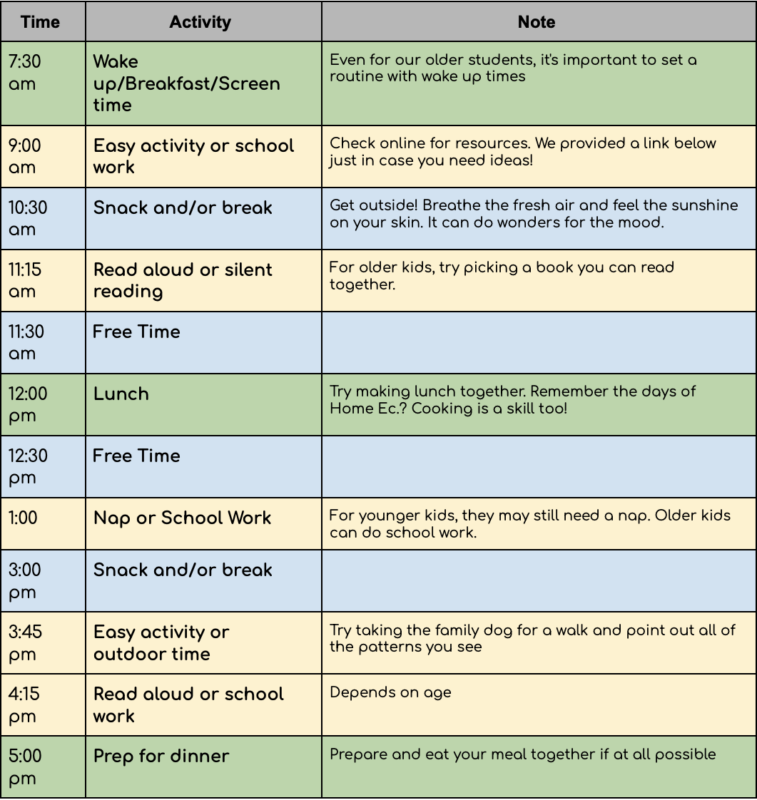With the recent health events resulting in school closures, you are probably finding yourself assuming an additional role – that of your child’s lead teacher. While this time may feel like a vacation from school for some, we need to create structures and routines that best support learning that will need to occur at home. And these structures and routines need to be things that we can stick with for some time.
Believe it or not, students appreciate structure – especially in their learning environments. They may not admit it, but they rely on the expectations and norms found in the classroom environment to support their ability to take risks associated with learning. It’s intimidating to ask a question in front of your peers or to try and explain a difficult concept to a loved one, when there are supports in place it can help boost a child’s confidence to participate in these activities. By providing structure at home you are reinforcing the consistency and safety that school brings, reminding your children that it is okay to make a mistake. Sometimes the best discoveries are made from mistakes!
Next, we need to dive into the current climate surrounding your child’s education. Schools and online resources are offering families an abundance of material and ideas. Teachers all over the nation are learning to use features on online platforms that may be new to them. Your friends are sending you links to hands-on experiments and activities you can do with your child. Your children were sent home with packets of work to do. How can you make sense of it all?
Below are six tips to help you make the most of your time as your child’s classroom teacher.
1. Set a schedule. Often, kids are visual learners. It may be helpful to post your schedule – even if it’s just a general outline on a piece of scrap paper taped to the refrigerator. That way, both you and your kids know what to expect. Here is an example of a schedule:

Or better yet, sit down and come up with a schedule with your kids! You will be pleasantly surprised how close their plan comes to what you had in mind.
2. Discuss your expectations. Similar to the schedule, kids do best when they know what to expect. Try explaining to them that there can be some flexibility in the schedule, but your goal is to spend these specific times doing schoolwork or activities. Make sure to point out that there is free time worked in!
3. Provide feedback. Let your students (… oh, I mean your wonderful children!) know what they are doing well on and what they might need a little more work with. Try to give specific feedback as well. Refrain from saying, “great job, you did your homework.” Rather, spend some time looking over it together. Maybe try to explain how, when they showed their work on the math problem, it helped you to understand the answer. Or ask them to include more information when answering a scientific question. The more meaningful the feedback, the deeper you can push your kids!
4. Open-ended questions. Thinking of questions to ask kids can be hard. This is true even for the most experienced of teachers! Set a goal of asking your kids questions every day. You might ask one question on day one, two questions on day two, etc. Or maybe you feel more comfortable with one question for week one… that’s okay too! The more you think about asking purposeful questions, the easier it will become. Focus on asking open-ended questions that promote higher-order thinking. For example:
- What do you predict would happen if ________? (Change the scenario or ask students to think ahead)
- How does ________________ affect ___________? Or, how do _____ and _____ affect each other over time?
- What do you think would happen if we did _________?
- What are the key parts of that? Let’s draw a model or diagram!
- Can you explain that so your smaller child would understand?
- What kinds of materials is this made of?
5. Find learning opportunities in real-world contexts. Learning happens all around us every day. Real-world experiences are the most authentic way to get your kids interested and engaged. Whether it’s making dinner and measuring out fractions or tinkering with string to figure out how to hang the mobile you created, these activities are learning activities.
6. Take a deep breath and try to relax. Cut yourself some slack. Teaching is hard work and arguably even harder when it is with your kids. Now, add in trying to work from home at the same time. It’s not easy. Setting a schedule that works for all of you is the first step. The next step is giving yourself time to adjust and taking it one day at a time. In the meantime, we are here to help. Consider following some of our suggestions or take a look at the list of resources we are compiling to help with at-home learning. Also make sure to keep your eye on the Connecticut Science Center Blog for daily activities that you can try at home.

Lindsey Sullivan is a Professional Learning Specialist at the Connecticut Science Center’s Mandell Academy for Teachers. Before joining the Mandell Academy, Lindsey was a high school science teacher. Currently, Lindsey supports educators as they make sense of NGSS through her facilitation of workshops offered by the Mandell Academy as well as providing coaching support in schools.
Holly Hollander serves as the Director of the Mandell Academy for Teachers. Prior to joining the Connecticut Science Center, Holly worked both in the public school setting as well as in Higher Education bringing with her a great deal of expertise in teaching and learning.


